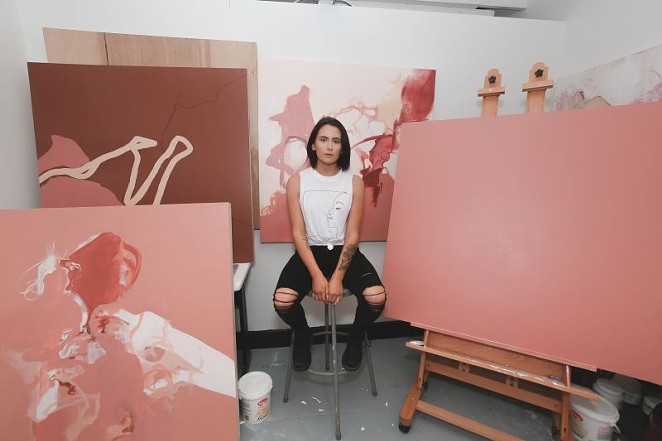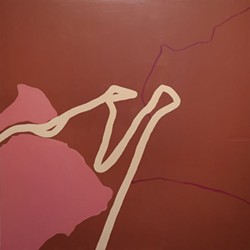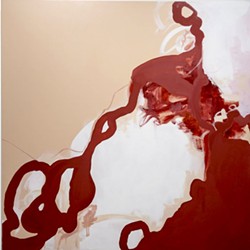NORA Harrison’s solo exhibition, "Hollow," combines her two loves of poetry and painting.
Her abstract paintings are inspired by the female form and use a romantic color scheme. The titles of her pieces come from her accompanying book of poetry.
She’s also attuned to Instagram culture and embraces that shift, both in her exhibition and in her work.
Harrison is a senior painting major at SCAD set to receive her MFA in just a few weeks. She’s done time in the Los Angeles art scene and sets her sights on New York next.
We talked to Harrison last week.
1. How did you get started with this body of work?
I settled on the name “Hollow” because I just self-published my own book, and it’s called “Hollow” as well. That plays into my work a lot.
I used to do all large-scale female nudes, 9 feet or so, and I started thinking it was too much. All people see is the naked female body and they can’t get past it. So I started easing into more abstract work, and they’re mid- to large-scale work with a very traditional color palette. Bright reds, a lot of pinks and nude tones. It seems feminine, but it also seems very romantic, and I love that feeling. It also expresses colors of passion, and all the line work is based off the female body.
I decided on “Hollow” because it’s a human emotion everyone can relate to in some way. I think we all experience hollowness, even if it’s just for a moment. For other people it’s a lifetime, depending on small tragedies we all experience. I wanted it to be something everyone could relate to and find their own belonging in the pieces. That’s where it all came from.
All the pieces are named after a line or a title of one of my poems. That was a way to integrate my writing with my actual work. I never really knew how to do that, and I was inspired by artists like Tracy Emin. It’s just insane how she does it so well. It always seemed so straightforward or forced if I put it right on the canvas. This was a way to give viewers or whoever purchased my artwork more of an intimate connection between me and the insight of what these pieces were inspired by.
2. When did you begin writing poetry?
I was always interested in artwork—my dad’s an architect, and I was in his office and drawing and painting as a little kid. I guess it was really in high school I went through, like everyone else, some terrible things. In some ways, you feel like they’re nearly destroying you, especially at that age. So at times when I felt I wasn’t able to paint, I would start writing. Instead of paying for therapy, I would write about everything. When I started writing, it was the only way I could get out my emotions and deal with things. When you write about your demons, it sets them free.
I wrote an excerpt at the end of the book saying, “I literally just started writing because I was sad and didn’t know how else to deal with it.” It’s that simple. Over the past year or so, I was really happy. I fell in love, in a good type of love that heals you, and in a way I’m okay if this is the only book I ever write because it proves it’s harder to write about happiness. It doesn’t feel necessary.
3. What’s the exhibition going to be like?
I want it to be so much more approachable. I got custom-made neon signs of titles from the work in my dad’s handwriting, and they’re in vibrant red that matches all the paintings. These will be in the show, too. It’ll be something really interesting to draw people in and make it not such a sterile painting exhibition. This is also Instagram culture, of course—I feel like people will love to take pictures. I didn’t want it to feel sterile or super intense, like if you don’t know about art you can’t come to this exhibition.
4. Let’s talk about Instagram culture. How do you embrace it?
With Instagram culture, people don’t want to see you post a piece of your artwork or your writing. It seems like they don’t care because it’s just not relevant to them. I want people to feel like they can look at art and be a part of it, even if they don’t care about it as much. People want that human interaction. You almost either have to embrace it somehow and find a way to make it work for you, or you just fall into the void.
That’s what they teach us with our artist Instagrams. Around 70 percent should be your work and your process and posting stories about you in the studio, but you also have to have some personal touches in there. No one’s going to feel like they can build a relationship with you if they only see your artwork. They need to see the other side of it. Once you have an understanding of a person and where their art’s coming from, it makes the work seem more valuable to you.
5.What’s next for you?
I graduate in June. I’m set to move to New York about a week after graduation. I already tried the LA art scene—I worked at Patrick Painter Gallery last summer—and it’s very different. I feel like it’s based more on how you look and the social context of things, and not about how talented you are.
So I’m moving to New York. I don’t have a job set up yet, but I love working in galleries. I love the social aspect of it and meeting artists and curating shows. In an LA art show I was able to curate four of the six booths, which is incredible. I really like that side of it, and I’d also love to get representation by a gallery. That’s what I’m working on right now.




